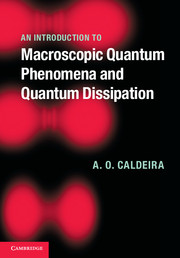Book contents
- Frontmatter
- Dedication
- Contents
- Preface
- Acknowledgments
- 1 Introduction
- 2 Elements of magnetism
- 3 Elements of superconductivity
- 4 Brownian motion
- 5 Models for quantum dissipation
- 6 Implementation of the propagator approach
- 7 The damped harmonic oscillator
- 8 Dissipative quantum tunneling
- 9 Dissipative coherent tunneling
- 10 Outlook
- Appendix A Path integrals, the quantum mechanical propagator, and density operators
- Appendix B The Markovian master equation
- Appendix C Coherent-state representation
- Appendix D Euclidean methods
- References
- Index
3 - Elements of superconductivity
Published online by Cambridge University Press: 05 April 2014
- Frontmatter
- Dedication
- Contents
- Preface
- Acknowledgments
- 1 Introduction
- 2 Elements of magnetism
- 3 Elements of superconductivity
- 4 Brownian motion
- 5 Models for quantum dissipation
- 6 Implementation of the propagator approach
- 7 The damped harmonic oscillator
- 8 Dissipative quantum tunneling
- 9 Dissipative coherent tunneling
- 10 Outlook
- Appendix A Path integrals, the quantum mechanical propagator, and density operators
- Appendix B The Markovian master equation
- Appendix C Coherent-state representation
- Appendix D Euclidean methods
- References
- Index
Summary
Superconductivity was discovered by Onnes (1911), who observed that the electrical resistance of various metals dropped to zero when the temperature of the sample was lowered below a certain critical value Tc, the transition temperature, which depends on the specific material being dealt with.
Another equally important feature of this new phase was its perfect diamagnetism which was discovered by Meissner and Ochsenfeld (1933), the so-called Meissner effect. A metal in its superconducting phase completely expels the magnetic field from its interior (see Fig. 3.1). The very fact that many molecules and atoms are repelled by the presence of an external magnetic field is quite well known, as we have already seen in the preceding chapter. The difference here lies in the perfect diamagnetism, which means that it is the whole superconducting sample that behaves as a giant atom!
This effect persists (for certain kinds of metal) until we reach a critical value of the external magnetic field, H = Hc(T), above which the superconducting sample returns to its normal metallic state. Moreover, at fixed temperature, this effect is completely reversible, suggesting that the superconducting phase is an equilibrium state of the electronic system. The temperature dependence of the critical field is such that Hc(Tc) = O and Hc(0) attains its maximum value as shown in Fig. 3.2.
- Type
- Chapter
- Information
- Publisher: Cambridge University PressPrint publication year: 2014



